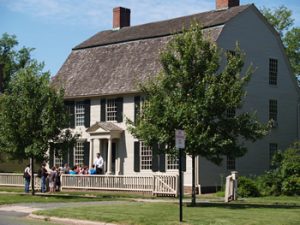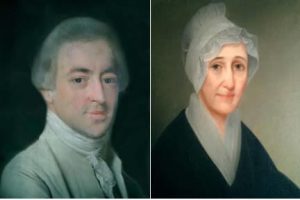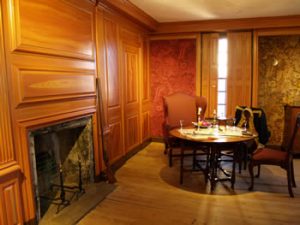After the Americans’ stunning victory at Saratoga on October 17, 1777, King Louis XVI ordered his ministers to negotiate a formal alliance between France and the United States. Conrad Alexander Gérard of France and Benjamin Franklin, Silas Deane, and Arthur Lee of the United States negotiated the terms of the Franco-American alliance in the Treaty of Amity and Commerce, which they signed on February 6, 1778.
The Treaty of Amity and Commerce served as formal notice that France recognized the independence of the United States. King Louis XVI and his ministers saw the United States’ fight for independence as an opportunity to avenge the losses France suffered during the Seven Years’ War. They also saw it as an opportunity for France to supplant Great Britain as the Americans’ chief trade partner. On March 17, 1778, France declared war on Great Britain.[1]
In July 1780, French General Jean-Baptiste Donatien de Vimeur, comte de Rochambeau landed in Newport, Rhode Island. He came with seven ships-of-the-line, four frigates, and thirty troop transports, which carried nearly 5,500 French soldiers. Rochambeau arrived with orders to assist the American Commander-in-Chief in a subordinate capacity. To this end, Rochambeau and George Washington met in mid-September 1780. They conferred in Hartford, Connecticut, halfway between Rochambeau’s headquarters in Newport and Washington’s headquarters in New Windsor, New York. The threat of attack from the British fleet kept their initial meeting short.
The two generals conferred again in May, 1781. On May 8, Rochambeau received dispatches with the news that the French government had ordered Admiral François Joseph Paul de Grasse and his fleet to the West Indies and that de Grasse would be available to support Rochambeau and the Americans during the 1781 campaign season. Rochambeau, Washington, and their retinues gathered at Wethersfield, Connecticut to discuss strategy.

Washington had wanted to meet Rochambeau in Hartford, but the city lacked proper accommodations as the Connecticut General Assembly sat in session. Located less than five miles south of Hartford, Washington selected Wethersfield on the advice of his aide-de-camp Samuel Blachley Webb. Webb had grown up in Wethersfield. His brother Joseph owned the family house. Webb suggested that Washington stay at his brother’s home and meet with Rochambeau there.
Joseph Webb’s house provided Washington with a suitable place to lodge and meet with Rochambeau. Joseph Webb Sr. had commissioned Judah Wright to frame the three-and-a-half story house and shop in 1752. The house conveyed the wealth of the successful merchant. When Joseph Sr. died in 1761, his eldest son Joseph Jr. inherited it. After 1774, the Webb house became known as “Hospitality Hall” because of all the lavish parties that Joseph Jr. and his wife Abigail Chester hosted.

Washington stayed in Joseph Webb’s house for five nights. He conferred with Rochambeau in one of the front parlors on May 21 and May 22. During their meetings, Washington and Rochambeau outlined plans for a combined French-American offensive. The two generals disagreed on where to attack. Washington wanted to attack New York City, while Rochambeau wanted to march south. [2]
Washington favored an assault on New York City because Henry Clinton had sent most of his regulars to the southern theater. Washington believed that a joint French-American assault would be able to recapture New York City from Clinton’s reduced garrison. Washington also disliked the idea of marching his army into the south in the summer heat.
Rochambeau disliked Washington’s plans for New York City. He believed that they would need more than their combined 8,300 men to retake the city. He also feared that de Grasse’s French fleet would not be able to help with an attack on New York. French ships tended to be larger than British ships and New York Harbor contained many shallow areas. Hence Rochambeau preferred to assault the British somewhere along the Chesapeake Bay.
By the end of their meeting on May 22, the two generals agreed that Rochambeau and his soldiers would meet Washington and his army at New Windsor. Together they would decide whether they could attack New York City. If not, they would march south and attack the British somewhere along the Chesapeake Bay where de Grasse’s fleet could assist them. [2]
The plan Washington and Rochambeau devised in Joseph Webb’s house set the stage for the Yorktown Campaign. Today, you can visit the Webb House and see the room where Washington slept and the parlor where he and Rochambeau formulated their strategy. The Webb House forms one-third of the Webb-Deane-Stevens Museum, a group of houses owned and operated by the National Society of The Colonial Dames of America in the State of Connecticut.

Revolutionary War buffs and George Washington fans will find the Webb-Deane-Stevens Museum a real treat. On the second floor of the Webb House you can visit the Washington bedchamber. Washington really slept in the Webb House; he wrote about his stay in his diary. The Museum has dressed the bedchamber to depict what it might have looked like during Washington’s stay. The room contains a reproduction of Washington’s military coat and Samuel Blachley Webb’s sword, which he wore to Washington’s first inauguration as President. [4] The most unique artifact in the room is the wallpaper.
On one wall of the Washington bedchamber hangs the original wallpaper that Joseph Webb Jr. had installed between 1765 and 1766. The wallpaper is a rare find because of its age and good condition. It also hung in the room during Washington’s stay. Although you won’t be able to see it, the back of the wallpaper contains the tax stamp from the Stamp Act of 1765.
On the first floor, you can stand in the parlor where Washington and Rochambeau met. Unlike the second floor, which interprets the history of the American Revolution, the first floor depicts the early 20th century when artist Wallace Nutting owned the house. Nutting knew what Washington and Rochambeau had done in the Webb House and he acquired the building to save it from destruction in 1916.
Nutting spent time and money fixing and decorating the Webb House. In the front parlor you will find oil-on-canvas wall murals. Nutting commissioned three artists from Hartford to paint them. The murals depict scenes from the American Revolution. Although historically inaccurate, (one mural portrays Cornwallis’ surrender to Washington; Cornwallis’ subordinates surrendered to Washington’s subordinate Benjamin Lincoln), they showcase 20th-century historical memory about the Revolution.
Those interested in military history might enjoy the annual Revolutionary War encampment hosted by the Webb-Deane-Stevens Museum each May. During the encampment, re-enactors portray a British assault on the 5th Connecticut Regiment and demonstrate18th-century horsemanship. This year’s encampment will take place on May 24, 2014.
Finally, Revolutionary War buffs will also enjoy the Webb-Deane-Stevens Museum because it contains not one, but two houses associated with the American Revolution. The house of Silas Deane, Continental Congressman and the first United States Envoy to France, stands next door to Joseph Webb’s house. Tours of the Deane House are included with Webb House admission.
[FEATURED IMAGE AT TOP: Northeast Parlor showing murals installed by Wallace Nutting in 1916. Courtesy of the Webb-Deane-Stevens Museum.]
The author thanks Adam D. Shprintzen and Zerah Jakub of the Fred W. Smith National Library for the Study of George Washington at Mount Vernon for their assistance in locating Washington’s journal entries and verifying information for this article.
[1] Yale Law School. “The Treaty of Amity and Commerce Between The United States and France.” The Avalon Project, February 6, 1778. http://avalon.law.yale.edu/18th_century/fr1788-1.asp; Eliga H. Gould. Among the Powers of the Earth: The American Revolution and the Making of a New World Empire. First. Cambridge, Massachusetts: Harvard University Press, 2012.
[2] George Washington. “Diary Entry.” National Archives: Founders Online, May 19, 1781. http://founders.archives.gov/documents/Washington/01-03-02-0007-0001-0018.
[3] Washington, George. “Diary Entry.” National Archives: Founders Online, May 22, 1781. http://founders.archives.gov/documents/Washington/01-03-02-0007-0001-0021.
[4] The Webb-Deane-Stevens Museum commissioned their reproduction of Washington’s coat with specifications from the Society of Cincinnati.










5 Comments
Wonderful article. Thank you!
Great article. I lived about 15 miles north of Hartford for a few years and was amazed at how much history took place there, and statewide. That being said, a tourist would have no idea that the Old State House in Hartford was the first meeting place between Washington and Rochambeau unless they knew what they were looking for beforehand. Hartford doesn’t market much of their rich history except for Mark Twain’s house.
I always though Hartford would be a good spot for a small revolutionary war museum. The state was a major producer of provisions for the Continental army during the war. There was the Battle of Ridgefield, Battle of Groton Heights, smaller battles in the New Haven area, and Old Newgate Prison, which I believe was renovated recently. The formulation of the Ticonderoga attack primarily took place in Hartford. Then there are the natives that were major figures during the war, Benedict Arnold, David Wooster, Israel Putnam, and Roger Sherman, all from the New Haven area, Jonathan Trumbull, Nathan Hale, and Ethan Allen. Many soldiers and officers in the northern theater came from Connecticut, with the most dominating being Arnold during the first three years of the war.
As you mentioned, Silas Deane, a good friend of Arnold’s, was up in Wethersfield. (The Webb-Deane houses are highly recommended) There was also a massive amount of privateering along the coast, and raids from the shoreline to Long Island, and Norwalk was kind of a base for receiving intelligence from the Culper Ring.
Dear Dr. Covart –
fascinating story very nicely told but please allow me a few corrections/clarifications/additions.
Paragraph 1 states that King Louis XVI “ ordered his ministers to negotiate a formal alliance between France and the United States. Conrad Alexander Gérard of France
Gérard (1729-1790) is the Secrétaire du Conseil d’Etat; the Foreign Minister is Charles Gravier, comte de Vergennes (1717-1787).
… negotiated the terms of the Franco-American alliance in the Treaty of Amity and Commerce …
–> No: the terms of the alliance are stipulated in the Treaty of Military Alliance which is signed the same day.
Paragraph 2 states that “On March 17, 1778, France declared war on Great Britain … . “
The other way round: on 13 March 1778, Louis XVI officially informed the Court of St. James of the Treaty of Amity and Friendship and of the Treaty of Military Alliance. Upon hearing the news, the Court of St. James recalled its ambassador from France on 16 March and declared war on France on 17 March. On 17 June, Royal Navy vessels led by the 36-gun HMS Arethusa chased the 26-gun French frigate Belle Poule off the coast of Normandy. The Belle Poule held her ground and once HMS Arethusa had lost her main mast limped, badly damaged and with half of her crew dead or wounded, into Brest. An Acte Royal by Louis XVI set 17 June 1778 as the official starting date of hostilities.
“By the end of their meeting on May 22, the two generals agreed that Rochambeau and his soldiers would meet Washington and his army at New Windsor. ” That should probably read “New York” – there is no need to march to New Windsor in preparation for an attack on New York City.
This statement might raise some eyebrows: “The plan Washington and Rochambeau devised in Joseph Webb’s house set the stage for the Yorktown Campaign.” The plan the two generals agreed on was to attack New York City – since Washington was C-i-C he had the last say – on land. The ultimate decision as to the target of the 1781 campaign was made by de Grasse: land forces would have to go wherever de Grasse appeared with his fleet. Not to forget Cornwallis: if he keeps marching north toward Baltimore, as some feared, or further in-land toward Richmond and the Blue Ridge Mountains, even de Grasse can not help the allies, no matter how many vessels he brings up from the West Indies.
Bob
Great work on the article. I am always surprised how much detail we have on the day-to-day of all these people. I find it hilarious how the painting of Joseph looks as if someone had dressed up my grandfather. I’d love to send the image to my father and see if he can figure out who it is. Thank you for all your work.
I am looking for a list of the American officers that were in Wethersfield at the Wethersfield Conference in May 1781. They spent the evening at the tavern of my 4th great grandfather William Collier in Hartford on May 23rd and racked up quite a bill that was paid for by the General Assembly at public expense. I am also looking for any diary entries from this date that refer to Collyers. Governor Trumbull mentions the tavern in his post. GW does not mention that evening. Any suggestions?